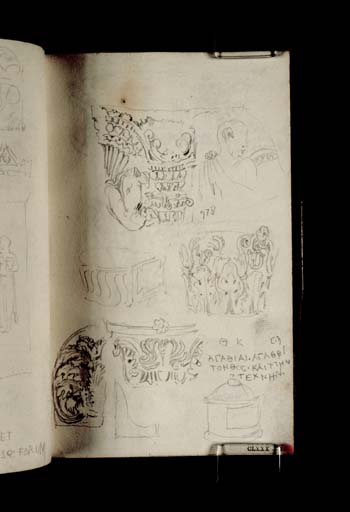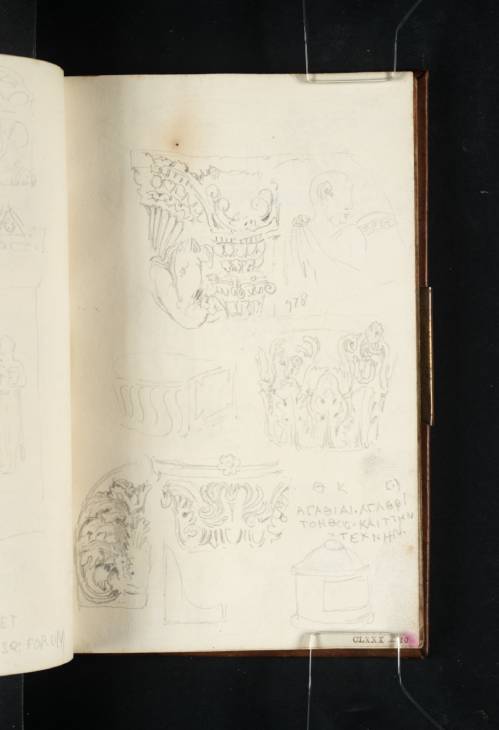Joseph Mallord William Turner Studies of Sculptural Fragments from the Vatican Museums, Including Architectural Features and an Ash Urn 1819
Image 1 of 2
-
 Joseph Mallord William Turner, Studies of Sculptural Fragments from the Vatican Museums, Including Architectural Features and an Ash Urn 1819
Joseph Mallord William Turner, Studies of Sculptural Fragments from the Vatican Museums, Including Architectural Features and an Ash Urn 1819 -
 Joseph Mallord William Turner, Studies of Sculptural Fragments from the Vatican Museums, Including Architectural Features and an Ash Urn 1819 (Enhanced image)Enhanced image
Joseph Mallord William Turner, Studies of Sculptural Fragments from the Vatican Museums, Including Architectural Features and an Ash Urn 1819 (Enhanced image)Enhanced image
Joseph Mallord William Turner,
Studies of Sculptural Fragments from the Vatican Museums, Including Architectural Features and an Ash Urn
1819
Joseph Mallord William Turner 1775–1851
Folio 21 Recto:
Studies of Sculptural Fragments from the Vatican Museums, Including Architectural Features and an Ash Urn 1819
D15143
Turner Bequest CLXXX 20
Turner Bequest CLXXX 20
Pencil on white wove paper, 161 x 101 mm
Inscribed by the artist in pencil (see main catalogue entry)
Inscribed by John Ruskin in red ink ‘20’ bottom right
Stamped in black ‘CLXXX 20’ bottom right
Inscribed by John Ruskin in red ink ‘20’ bottom right
Stamped in black ‘CLXXX 20’ bottom right
Accepted by the nation as part of the Turner Bequest 1856
Exhibition history
2008
Turner e l’Italia/Turner and Italy, Palazzo dei Diamanti, Ferrara, November 2008–February 2009, National Gallery of Scotland, Edinburgh, March–June 2009 (42, reproduced in colour).
2009
Turner és Itália, Szépmuvészeti Múzeum, Budapest, July–October 2009 (no number, reproduced).
References
1909
A.J. Finberg, A Complete Inventory of the Drawings of the Turner Bequest, London 1909, vol.I, p.532, as ‘Exhibit No. “978” &c.’.
1984
Cecilia Powell, ‘Turner on Classic Ground: His Visits to Central and Southern Italy and Related Paintings and Drawings’, unpublished Ph.D thesis, Courtauld Institute of Art, University of London 1984, pp.413, 476 note 8, as ‘Architectural fragments and a grave urn (probably A, I, GLap, 94, not ill.).
1987
Cecilia Powell, Turner in the South: Rome, Naples, Florence, New Haven and London 1987, p.51 note 6.
2008
James Hamilton, Nicola Moorby, Christopher Baker and others, Turner e l’Italia, exhibition catalogue, Palazzo dei Diamanti, Ferrara 2008, no.42, pp.[179], 183, [211], reproduced in colour as ‘Roma. Schizzi di sculture ai Musei Vaticani, tra cui la tomba di Gaio Musico e Volumnia Ianuaria; frammenti architettonici e un’urna cineraria’.
2009
Christopher Baker and James Hamilton, Turner és Itália, exhibition catalogue, Szépmuvészeti Múzeum, Budapest 2009, p.53, reproduced p.45, fig.45.
During his 1819 stay in Rome, one of Turner’s most extensive sketching campaigns was the large number of pencil studies made from the sculpture collections of the Vatican Museums (for a general discussion, see the introduction to the sketchbook). This page contains sketches of several objects, some or all of which were probably found in the Museo Chiaramonti. The studies are numbered from top left to bottom right:
a.
The sketch at the top depicts part of an unidentified architectural fragment decorated with figures and an Ionic capital. Turner has annotated the drawing ‘978’ which presumably relates to an exhibit number displayed on the individual work. However, it does not appear to correspond to any known lists published within contemporary guide books or catalogues of the Vatican collections.
b.
The subject of this sketch is currently unidentified although it appears to depict an ash urn.
c.
A sketch of a Corinthian capital, the source of which is currently unidentified.
d.
The sketch in the bottom left-hand corner appears to depict an acroterion, an architectural ornament designed to be placed at the apex of a pediment. The source is currently unidentified, however, the object also features within a sheet of antiquities drawn by James Hakewill (1778–1843) in 1817 (British School at Rome Library).1
e.
An unidentified architectural fragment, possibly a capital, decorated with a stylised palmette motif.
f.
The sketch in the bottom right-hand corner of the page depicts an ash urn in the Museo Chiaramonti.2 Turner has transcribed the accompanying Greek inscription as ‘T ¿ F | ¿G¿T¿¿¿. ¿G¿T¿¿ | ¿¿ ¿T¿S. ¿¿¿ ¿¿¿¿ | ¿¿¿¿¿¿’ [Be good in your character and in your art].3
The sketch at the top depicts part of an unidentified architectural fragment decorated with figures and an Ionic capital. Turner has annotated the drawing ‘978’ which presumably relates to an exhibit number displayed on the individual work. However, it does not appear to correspond to any known lists published within contemporary guide books or catalogues of the Vatican collections.
b.
The subject of this sketch is currently unidentified although it appears to depict an ash urn.
c.
A sketch of a Corinthian capital, the source of which is currently unidentified.
d.
The sketch in the bottom left-hand corner appears to depict an acroterion, an architectural ornament designed to be placed at the apex of a pediment. The source is currently unidentified, however, the object also features within a sheet of antiquities drawn by James Hakewill (1778–1843) in 1817 (British School at Rome Library).1
e.
An unidentified architectural fragment, possibly a capital, decorated with a stylised palmette motif.
f.
The sketch in the bottom right-hand corner of the page depicts an ash urn in the Museo Chiaramonti.2 Turner has transcribed the accompanying Greek inscription as ‘T ¿ F | ¿G¿T¿¿¿. ¿G¿T¿¿ | ¿¿ ¿T¿S. ¿¿¿ ¿¿¿¿ | ¿¿¿¿¿¿’ [Be good in your character and in your art].3
Nicola Moorby
November 2009
See Tony Cubberley and Luke Herrmann, Twilight of the Grand Tour: A Catalogue of the drawings by James Hakewill in the British School at Rome Library, Rome 1992, no.5M.19, reproduced p.313.
See Walther Amelung, Die Sculpturen des Vaticanischen Museums, Berlin 1903–8, vol.I, ‘3. Museo Chiaramonti I Seite 309–560’, no.306, p.516, reproduced pl.54, third from right on shelf. Not, as Cecilia Powell has suggested, Amelung, vol.I, ‘2. Galleria Lapidaria Seite 161–308’, no.94, not illustrated.
How to cite
Nicola Moorby, ‘Studies of Sculptural Fragments from the Vatican Museums, Including Architectural Features and an Ash Urn 1819 by Joseph Mallord William Turner’, catalogue entry, November 2009, in David Blayney Brown (ed.), J.M.W. Turner: Sketchbooks, Drawings and Watercolours, Tate Research Publication, December 2012, https://www

